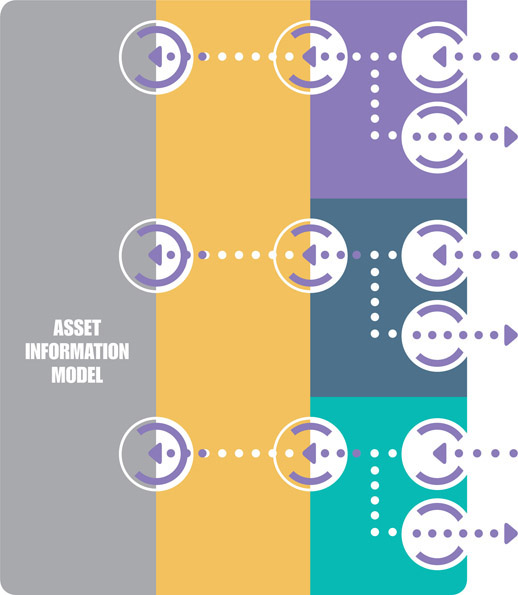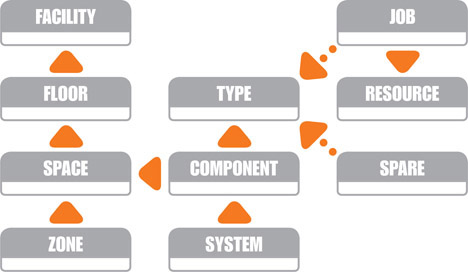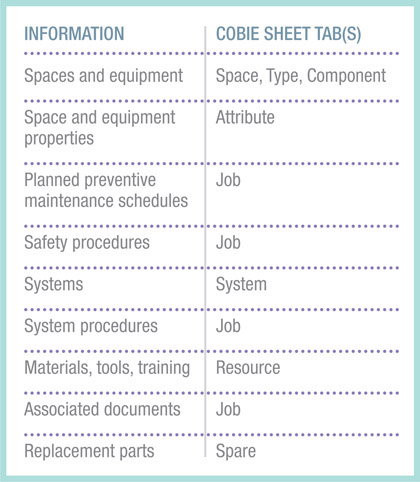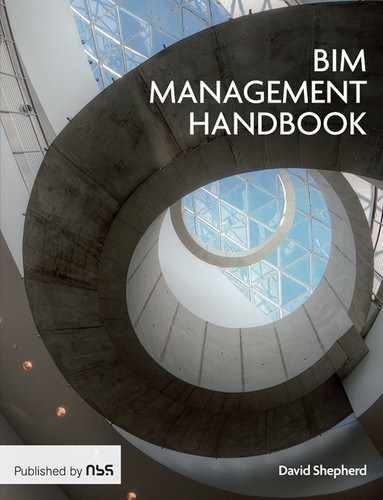10
BIM in the Hand-Over Phase

Introduction
In this final chapter, we consider the transition, by means of BIM, from coordinated project information in the project delivery phase to coordinated asset information in the operational phase.
The concept of the model is expanded beyond the building’s graphical representation to include the full array of coherently structured data developed in relation to it. In particular, COBie is the mandatory data structure for formal BIM Level 2 information exchange.
In respect of managing coordinated asset information, we review the publicly available specification, PAS-1992-31, which was developed in concert with PAS-1992-2 in order to provide a framework of generic guidance on how the asset information model should be developed from project information model.
The key coverage of this chapter is as follows:
- The importance of information management to operational cost-effectiveness
- What is an information model?
- Organisational information requirements
- Asset information requirements.
The Importance of Information Management to Operational Cost-Effectiveness
A much-debated construction industry rule of thumb, first published In the Royal Academy of Engineering paper The Long Term Costs of Owning and Using Buildings2, reads as follows:
‘If the initial construction costs of a building is 1, then its maintenance and operating costs over the years is 5, and the business operating costs (salary of people working in that building) is 200.’
The actual ratios can vary with a number of factors (e.g. land cost and the type and location of the building), what is not in dispute is the fact that operation and maintenance costs eventually dwarf those incurred during the design and construction phase. This means that access to reliable structured information about the former will have a far greater influence on the long-term ‘bottom-line’ than design and construction expenditure.
PAS-1192-31 is the ‘specification for information management for the operational phase of construction projects using building information modelling’. As the document explains of itself: ‘this PAS is fundamentally about availability, integrity and transfer of data and information during the operational phase of an asset’s life’.
In respect of the future management of any building, the handover of comprehensive, organised ‘as constructed’ asset data provides an improved baseline for budgetary decisions. It also forms a register for organising equally comprehensive data on regulatory compliance, maintenance and warranty agreements, suppliers, room inventories, method statements, business continuity impact assessments and health and safety notifications.
What is an Information Model?
For data to inform decisions, it must be capable of being searched and sorted by consistently formatted criteria. The information model is the logical organisation of data accumulated and verified over the course of the project in relation to computer-based elements. These elements, whether graphical or text-based, provide a ‘real world’ context for organising the data. The data itself can be categorised as follows:2
- Documents: officially formatted, recorded and change-controlled information, such as correspondence, drawings and schedules.
- Non-graphical information: Pieces of data about an element that are stored as consistently defined attributes, such as specifications and interrelated properties.
- Graphical information: Dimensional data relating to each element and represented as computer-based geometry.
In the broadest terms, the word ‘model’ goes far beyond just computer graphics and describes the logical organisation of data for the purpose of supporting the owner’s decision-making.
As long as its quality and currency is maintained, this logically organised data can be used to assist management in identifying opportunities to better utilise available capacity, to control costs and to provide greater flexibility in accommodating the requirements of the building’s occupants.
Organisational Information Requirements
Corporate strategy requires information as the rational basis for guiding the purchase, use, maintenance, and disposal of every asset that an organisation needs in order to maintain and develop its business.
This information should be sufficient to support comprehensive strategic decisions about how best to finance the acquisition of new assets, to maintain existing ones and to dispose of those that have reached the end of their economic life. In particular, organisational information is often required as summarised headlines that can be easily digested, rather than being itemised in fine detail.
As part of the Employer’s Information Requirements (see Chapter 2), the Organisational Information Requirements define the type of data that will inform strategic decisions by:
- Comparing the operations and maintenance (O and M) lifecycle costs (at net present value) of alternative capital investments.
- Scheduling all asset replacement values and maintenance costs.
- Assessing the total cost of maintaining (or temporarily deferring maintenance of) a specific asset(s)/asset system.
- Determining the operational and financial impact of asset unavailability or failure.
- Determining the end of economic life of assets/asset systems.
- Identifying the expiry of warranty period and warranty.
- Undertaking financial analysis of planned income and expenditure.
- Undertaking the ongoing identification, assessment and control of asset related risks.
- Complying with statutory and regulatory obligations.
Asset Information Requirements
There is also a need to provide the more detailed data that will ensure that more immediate operational value is derived from company assets. These Asset Information Requirements (AIRs) are more closely aligned with the day-to-day management of the building.
Typically, AIRs will describe the scope of information that must be developed by coordinating data extracted from ‘as constructed’ models and verified in order to provide a comprehensive fully populated asset register for the facilities management (FM) team at hand-over. The requirement should include:
- Descriptions of assets, their functions and the asset systems they serve.
- Locations of assets, possibly using spatial referencing or geographical information systems.
- Vendor data, giving details of the organisation that supplied the asset.
- Operating instructions
- Maintenance instructions such as SFG20 schedules
- Engineering data, design parameters, and engineering drawings
- Fault-finding instructions
- Commissioning instructions
- Commissioning dates and data
- Health and safety files
- Regular statutory test requirements.
It is through BIM Project Execution Plans and Information Delivery Plans (see Chapter 2) that the main contractor defines how data will be developed and collected through the supply chain and tested for quality before issue to the client. The consolidation of data from the sub-models of each sub-contractor is by a process known as model federation (as also described in Chapter 2).

Figure 10.1
Common Data Environment Project Information Model is verified and quality checked at handover to become Asset Information Model
Information Exchanges and the Project Process
Instead of simply preparing this accumulated information for final handover, data is extracted throughout the process, from progressively more precisely detailed and information-rich models, and sent to the client at milestones specified in the BIM Project Execution Plan. Issuing organised coherent information in this way is known as information exchange. In PAS-1192-2, an information exchange is described as a ‘structured collection of information at one of a number of pre-defined stages of a project with defined format and fidelity’. The CIC Outline Scope of Services for the role of Information Management describes it as ‘configured information delivered from the Information Model for a specific Permitted Purpose.’
In summary, an information exchange is ‘the delivery of data extracted from the model… configured in a format that enables the Employer (and others) to authorise further project development at key project stages.
The data is generated from the collaborative 3D environment, whereby all related documentation, non-graphical information and graphical information from the entire project team can be assembled into a comprehensive Project Information Model.’
According to Dale Sinclair’s Assembling a Collaborative Project Team,3 there are three types of information exchanges:
- Informal ‘work-in-progress’ information shared between design team members to allow each designer to progress their own design work, to facilitate collaborative working and to allow the lead designer to coordinate the developing design.
- Ad hoc information released to progress a particular topic with third parties (not included in the project team, e.g. local authority, or utility company.
- ‘Formal information exchanges… principally at a pause in the design process allowing a period for reflection and sign-off before the next stage commences.’
When issued, each type of exchange requires all data to be coherent in relation to what is known by the project team (rather than what is tentative). This is because BIM allows all project members to reference each other’s information for project-related purposes. For example, it would be a serious problem if, at a later design stage and despite using BIM, there was a major disparity between the ceiling heights specified in the architect’s room schedule and those in the services engineer’s model and schedules used to calculate volume for HVAC loads analysis.
The distinction between what should be relied on as certain and what remains tentative is established by assigning a progressive Level of Definition to different aspects of the issued data. For a given project work stage, this is the extent to which the graphical detail and non-graphical data can be relied upon for different purposes by members of the project team. This is explained in more detail in Chapter 9.
Aggregating and Sharing Asset Data
The development of the Project Information Model (see Chapter 2) must be managed over the entire project lifecycle, issued to the client in the form of data drops at the specified intervals, and finally verified at handover to become the Asset Information Model.
A checking regime must be established that ensures that:
- The model contains elements that are representative of every maintainable asset in the proposed building.
- Asset data (itemised in the above section on AIRs) is being added to all model elements.
This data must be refined in order to represent eventually accurate ‘as constructed’ information on the full complement of assets that comprise the completed building works.
Instead of opening the 3D model, the client and other stakeholders can derive considerable value from reviewing the development of the evolving Project Information Model as standardised ‘snapshots’ which tabulate the key properties of the assets intended for the proposed building. For BIM Level 2, PAS-1192-2 and PAS-1192-44 mandate the use of the internationally recognised and non-proprietary data structure (i.e. schema) known as Construction Operations Building Information Exchange (or, as specified for the UK, COBie-UK-2012). This can be imported into a wide range of compatible FM software.
COBie
COBie provides a means of digitally exchanging structured, progressively more definitive asset information for the design, construction and hand-over phases.
The majority of BIM software vendors provide tools for exporting this data directly from the model. Although the commonest approved output is an Excel spreadsheet, there are other approved file formats, such as ifcXML.

Figure 10.3 The COBie data structure7
Each tab on the COBie spreadsheet is assigned to record different types of interrelated asset data.
For each project work stage, there is a progression in the level of information issued to the client via this COBie spreadsheet.

Cobie drop 1: Requirement and constraints (room data sheets)
Cobie drop 2: Outline solution
Cobie drop 3: Construction Information
Cobie drop 4: Operation and maintenance
Cobie drop 5 (or more): Operation and maintenance post occupancy
Model Integrity
As a word of warning, it is important to establish a regime for maintaining model integrity, especially in respect of exporting COBie data that will be issued to the client. Model integrity refers to the accuracy and consistency of elements and associated data that comprise the model. If the model contains extraneous or duplicated elements, its exported data (including COBie) cannot reliably represent design intent or construction information for a particular work stage.
In order to identify anomalies, regular visual scrutiny of extracted worksheets should be coupled with the use of either an add-on or dedicated model checking application (such as Solibri Model Checker®). The latter provides a set of automatic rules that can eliminate the above-mentioned discrepancies from the model before export to COBie.
Government Soft Landings and FM Workshops
COBie data provides not only a consistently organised summary for end-users to assess how the project is meeting the requirements in the brief, but also, once verified, an asset database for handover to FM. As such, its data is invaluable for early engagement with end-users on how the design will meet the specified requirements, as well as for post-construction after-care.
Government Soft Landings (GSL) is a major public policy that encourages end-users to engage with the project delivery process at every stage, from design to construction to hand-over and post-occupancy. It was established by the UK government to ‘improve performance of buildings and to meet the requirements of those that use them’.5

Beyond project delivery, a stated guiding principle of GSL policy is that ‘Building Information Modelling (BIM) will provide a fully populated asset data set to feed into Computer Aided Facilities Management (CAFM) system. This data will need to be maintained throughout the building life cycle. The Cabinet Office documentation on GSL notes that, on government projects, this aspect of the guidance is mandatory and must be followed to comply with the policy.
A Soft Landings Champion is appointed to spearhead early end-user engagement with the project team during design and construction. Part of this engagement includes FM workshops aimed at evaluating the eventual usability of the asset, and preparations for hand-over as the intended facility evolves in design.
Table 10.2 contains a number of key examples that show how information derived from BIM, including COBie, should be used during each project work stage.
Thus, the COBie worksheets should be used in combination with other design information as a valuable progress check. Nevertheless, it may be necessary to establish a more direct workflow for collating and publishing asset data from supply chain models into CAFM after verification by the Soft Landings team.
The long-term value of digital transfer from the federated model to CAFM is that it eliminates much of the cost and time involved in collating FM data through major post-project asset auditing. As described in the Facilities Management Service Standards within the Central Government Office Estate6, if completed properly, this process will deliver a comprehensive ‘asset list of all plant and equipment which can be kept regularly updated – to a level applicable for performing routine maintenance (PPM) and also undertaking full condition/remaining life surveys on all built assets (in scope).’
While there is a growing list of Computer Aided Facilities Management (CAFM) software that is capable of importing COBie data, the BIM Manager should hold workshops with the FM team to identify and test other formats (such as IFC). Alternative data translation workflows (using software, such as FME Desktop®) may be needed to export from them reliably into the Employer’s CAFM System.
Conclusion
Beyond the production of conventional project outputs, COBie data is now an important BIM Level 2 expectation of the employer. In order to maintain the quality of this data throughout the supply chain, a regime must be instituted to regularly audit all sub-models for extraneous and duplicated elements.
Before exporting to COBie, information quality must be checked by designers. They should scrutinise all relevant BIM schedules that relate to their specialties. Also, after training and documenting the process for the supply chain, and in readiness for ‘data drops’, trial runs of the full COBie export should be conducted. These should involve testing the process of aggregating this exported data from the entire supply chain.
The BIM Manager should also conduct workshops throughout the project with the Soft Landings Champion and FM team to ensure that the trial COBie data can be imported into the CAFM system without data omissions or errors. If the system is not COBie-compatible, alternative data translation tools, such as FME Desktop®, may be required.
In accordance with the BIM Project Execution Plan, BIM Managers should establish a project delivery check-list of model set-up, standardised production processes and implementing quality control for all deliverables.
